Discovering World War I at the History Center, Part 4: The Elsie Janis Memorabilia Collection
Posted by Jane Metters LaBarbara.November 9th, 2018
Blog post by Michael Ridderbusch, Associate Curator, WVRHC.
On the 11th of this month of November, at 11:00 AM Paris time, will occur the 100th anniversary of the end of World War I. America suffered casualties of over 115,000 in this conflict, making it the third costliest war in American history, following World War II (over 400,000) and the Civil War (750,000). This sacrifice inspired President Woodrow Wilson in 1919 to ask Americans to recognize “those who had died in the country’s service.” In time, his moral injunction led to Congressional actions that ultimately established in 1957 Veterans Day as we know it today.
In times of relative peace, we of course recognize the service of those in the armed forces. In times of war we aspire to more. These aspirations often take the form of serving in hospitals, working in the arms industry, etc. In addition to these activities of material support, however, are ones of moral support to the troops. In the Second World War the United Service Organizations (USO), a nonprofit organization established by request of President Roosevelt in 1941, provided such support. Although many entertainers answered the call, the comedian Bob Hope has become most identified with the USO, so much so that the organization is currently known as the “Bob Hope USO.” He not only entertained during World War II, but also during the conflicts in Korea and Vietnam. Lesser known and even forgotten, however, is Elsie Janis, a vaudeville star who also entertained troops, albeit during World War I. Her rapport and connection to audiences of soldiers was so great that she was immortalized as “the sweetheart of the AEF” (American Expeditionary Force). The History Center has recently acquired memorabilia regarding Elsie Janis, including photographs, clippings, and other material documenting both her vaudeville years and World War I service.
Elsie Bierbower was born 16 March 1889 in Marion, Ohio, a small town 50 miles north of Columbus. By age 2 she was already performing on stage, and by 11 she attained success on the vaudeville circuit as a headliner under the stage name of “Elsie Janis.” Critical success led to engagements on Broadway and in London, including a number of hit Broadway shows, such as “The Vanderbilt Cup” (1906), “The Hoyden” (1907), “The Slim Princess” (1911), and “The Century Girl” (1916).
Our collection of memorabilia includes a number of items from this era:
On left: Booklet “marketing” Elsie Janis as a child star; 1900
On right: A photograph of Janis as a character in “The Slim Princess”; ca. 1911
(From collection A&M 4355, Clyde Cale, Collector, Memorabilia of Entertainer Elsie Janis.)
Top left: Newspaper article regarding her career,
indicating how she’s “smashing many box office records;” ca. 1912
Bottom left: Note card with original manuscript by Janis from the
“Davis Theatre” [in Pittsburgh]; March 1916
On Right: Portrait photograph; undated
(From collection A&M 4355, Clyde Cale, Collector, Memorabilia of Entertainer Elsie Janis.)
It was during a 1915 engagement in London that she stumbled into her vocation as an entertainer and morale booster of troops. In the introduction to her 1919 autobiographical account of her war years titled “The Big Show: My Six Months with the American Expeditionary Forces,” a compelling read of over 220 pages, she explains how this started. “I played again at the Palace [in London], and now began my first real taste of war. The wounded were coming home in thousands; the camps were full; and I spent every spare moment I had, and some I did not have, singing in hospitals and camps. It was then I learned what a little amusing story or a song can mean to a man before he goes into a fight or after he has ‘got his.'”
When the United States declared war on 6 April 1917 she had a new resolution: “From that time on I had but one idea, and that was to get to France and do for our boys what I had done for the others — for I thought, if the Tommies liked me in their own land and surrounded by their own families, what would our boys feel, three thousand miles away from home?”
Elsie Janis on the deck of an ocean liner, likely sailing between the United States and England.
She tells us in “The Big Show” that she sailed to England on the Lusitania in January 1915.
Later that year, in May 1915, the Lusitania was sunk by a German submarine,
a precipitating factor leading to America’s entry into World War I.
(From Library of Congress website.)
After she “started in at home” with “recruiting, playing benefits, and doing a ‘war-mad’ act in vaudeville, singing patriotic songs, etcetera” she set out for France in 1918. Once in France she performed at military bases, hospitals, and even near the front lines, all the while meeting soldiers, officers, generals, and French people of all kinds.
Her narrative of these experiences appeared in her book “The Big Show,” a story enlivened by descriptive details and humor. It also appeared in 1919 as installments in Hearst’s Magazine, along with many photographs that were not published in the related book; many of these installments were included in the collection of Janis memorabilia that was gifted to the History Center, and are sampled in this blog.
Elsie Janis meeting officers and generals of the AEF.
This picture appeared in Part III, “Such Rain — Such Mud!” in Hearst’s Magazine; 1919.
(From collection A&M 4355, Clyde Cale, Collector, Memorabilia of Entertainer Elsie Janis.)
—
In Part VI, “Exit Queen Nurse,” she tells many stories of her experiences in military hospitals, from which we will excerpt here.
Beginning of Part VI as it appeared in Hearst’s Magazine; 1919.
(From collection A&M 4355, Clyde Cale, Collector, Memorabilia of Entertainer Elsie Janis.)
“They were so crowded at the hospital that our poor boys were lying in the halls and in fact all over the place. I did not think to put on a hospital face — which is that sort of ‘My poor boy, where were you wounded’ expression, and I’m afraid I was perhaps a bit dressy. I remember thinking I was looking quite well, so when I bounded up to some very busy nurses and said I wanted to work in the wards I don’t think they quite understood my idea of ‘working’ in a ward. Luckily the first person who listened to my plea stuck her head in the door of a ward which was filled with boys who had sung with me and laughed with me a month before ‘Somewhere up Front,’ and when she said, ‘Boys, would you like to see Miss Elsie Janis?’ she was answered by a mixture of yells that I am sure never were heard before in a hospital.”
…
Elsie Janis “Somewhere up Front.”
This picture appeared in Part VII, “I Meet General Pershing” in Hearst’s Magazine; 1919.
(From collection A&M 4355, Clyde Cale, Collector, Memorabilia of Entertainer Elsie Janis.)
“I used to start by saying when I entered a ward, ‘Is there anyone in great pain here? because if there is, I won’t sing, as I don’t want them to blame it on my voice.’ And in the three weeks that I worked there every day, I never had one of them admit that he was in “great pain” three hours and four a day. I shall try to write briefly some of the little sayings of the boys, but before I do, I want to say that I thought I had seen badly wounded men during my hospital work before, but I have never seen boys ‘shot to pieces’ like those boys were. They had been really almost too brave. I said to one boy who was so swathed in bandages that all I could see was one very nice blue eye, and the corner of one very strong American mouth, ‘Well, old dear, you certainly got yours, didn’t you?’ He said, ‘Yes, I did, but the last time I seen the Germans they was running up a hill.'”
…
“There was a very fussy and serious-minded nurse in one ward, who rather resented my existence. I didn’t know of her until one day when I went in and over in a corner was one boy who was in great pain, I started leaping about as usual — and she came up to me saying, ‘Do be a little careful, poor John (pointing to the sufferer) is in great pain, and you might jar him.’ Whereupon said John lifted his aching head and spoke as follows: ‘Aw! Leave her alone. She is the first real live thing I’ve seen since I hit this joint. Go to it, Elsie,’ and I went to it. Exit Queen Nurse, peevishly.”
…
“Those three weeks were about the happiest of my life. I got to know the boys so well, made many real friends, and lost a few. It got so the boys would promise the nurses not to make a fuss when they had their wounds dressed if she would promise to bring Elsie in.”
“I sang sometimes in as many as fifteen wards in a day. I usually had a good cry when I got home, but my reward was in the fact that the boys wanted me, and it was with rather a heavy heart that I left them to go back to the Front, for it was rather up-hill work spurring our boys on after I had seen the results of a victorious battle.”
—
In addition to her hospital visits, she performed at the front under fire. In Chapter II of her book we learn how she was able to acclimate herself to conditions of war. It was during a dinner party with Anglo-French friends in Paris while German Gotha Bombers were raiding, a nightly event at that time:
“I think it was in the midst of the salade that the butler came and stood between the hostess and the gentleman on her left, and addressing them both, said: “The Gothas have arrived, my lady …. Will you have port, sir?”
“I looked at Mother, whose black eyes looked like shoe buttons in milk — and alive with expectancy, I let my gaze wander around the table, rather hoping to see one worried look. But No! they were all toying with an unsuspecting peach Melba. So I took a long breath and leapt onto mine as if it had been a German. Remarks about other raids and how many were killed floated on cigarette smoke … Coffee was served. I think I put salt in mine instead of sugar.”
“Someone went to the window and opened it. The noise was deafening. ‘They are here,’ said the window-opener. ‘Listen, you can hear the planes.’ I swallowed my salted coffee and ran to the window. Sure enough — ‘Brrr, brrr, brrr,’ sang the engines. I forgot everything in my anxiety to see.”
“‘Pit pat, pit pat,’ something was falling like rain. ‘Shrapnel,’ said the hostess. ‘Boom! brrr– gush!’ ‘Une bombe,’ said a lady with no back in her dress. I found myself wondering if she was not cold.”
“Une bombe! and perhaps twenty souls hurled into eternity without a warning. I came back to earth with a thud. Mother’s hand was in mine and the guests had gone into the drawing-room, already bored by the monotony of the guns. I squeezed Mother’s hand and said, ‘Well, dear, if our numbers are up, we will exit together.'”
“From that night I have never felt the slightest tremor even under fire at the Front. I have always felt that so many nice people have left this earth lately that one would have as many if not more friends on the other side. We went back into the drawing-room, where to the tune of the ‘Livery Stable Blues’ we danced through the rest of the raid, which lasted an hour and a quarter.” [In passing, we can mention here that “Livery Stable Blues” is generally considered to be the first commercially released jazz recording. It went on sale in March 1917, making jazz about one year old at that time, and about 100 years old in this time.]
Additional memorabilia in our collection:
Top left: Note card with original manuscript by Janis; March 1916
Bottom left: Note with original manuscript by Janis; 1941
On Right: Portrait photograph; undated
(From collection A&M 4355, Clyde Cale, Collector, Memorabilia of Entertainer Elsie Janis.)
—
In this blog we have learned why Elsie Janis became an entertainer of American troops, how she was able to cope with conditions of war, and something about what she did for American soldiers in France during WWI. It also provided a sampling of material from the Elsie Janis memorabilia collection at the History Center.
This blog is part of a continuing series commemorating the First World War. See also:
Discovering WWI at the History Center, Part 1: The John A. Thorn Collection
Discovering WWI at the History Center, Part 2: The Elmer A. Walton Collection
Discovering WWI at the History Center, Part 3: The World War I Poster Collection
—
Sources consulted:
Wikipedia:
American Expeditionary Force
Bob Hope
Elsie Janis
Gotha Bombers
RMS Lusitania
United Service Organizations
Veterans Day
Internet Archive:
Book by Elsie Janie, “The Big Show”






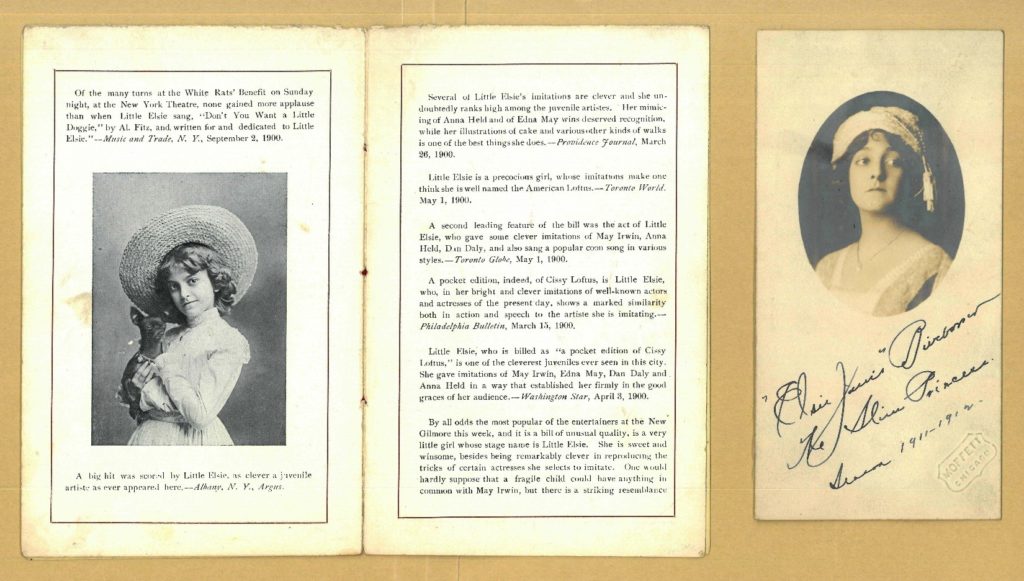
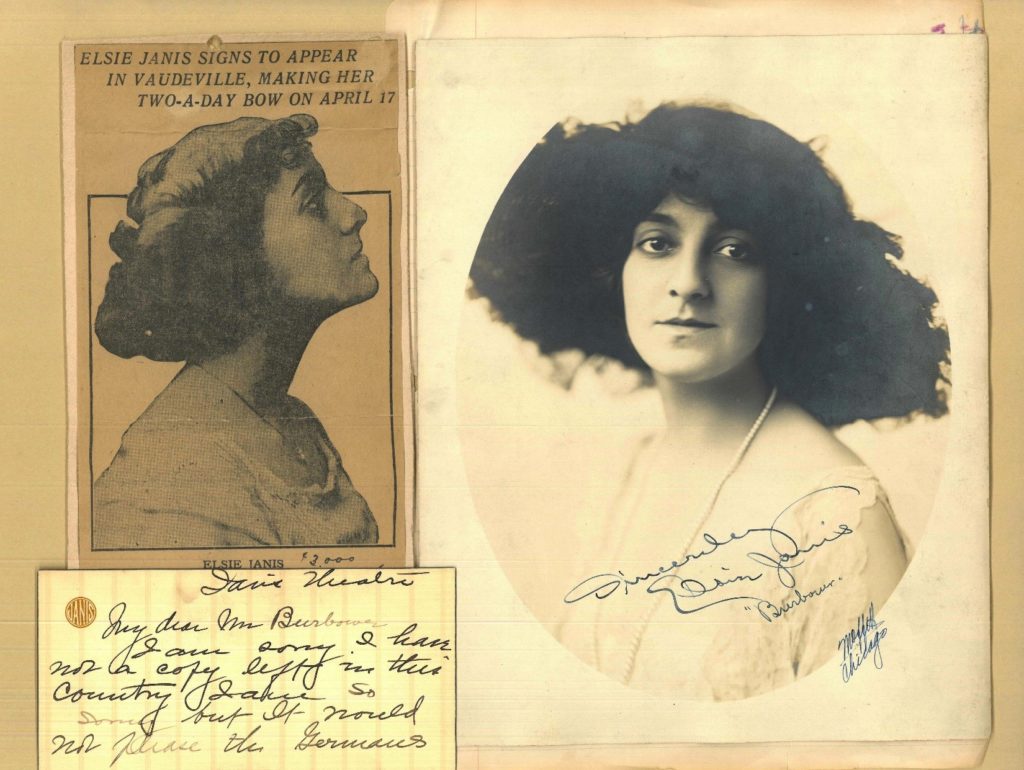
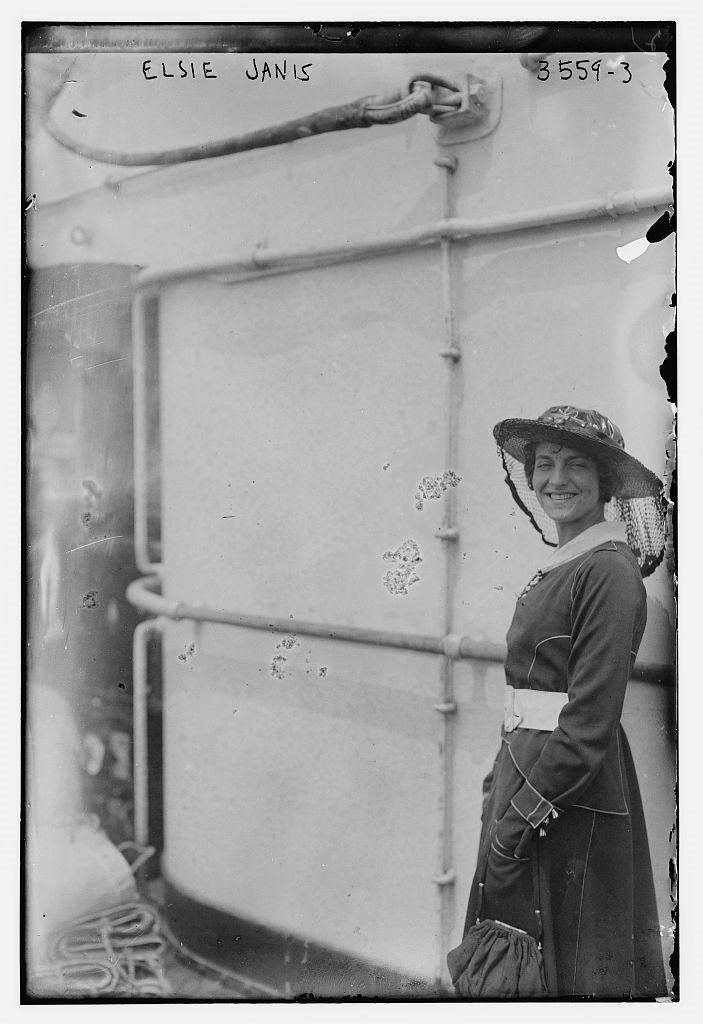
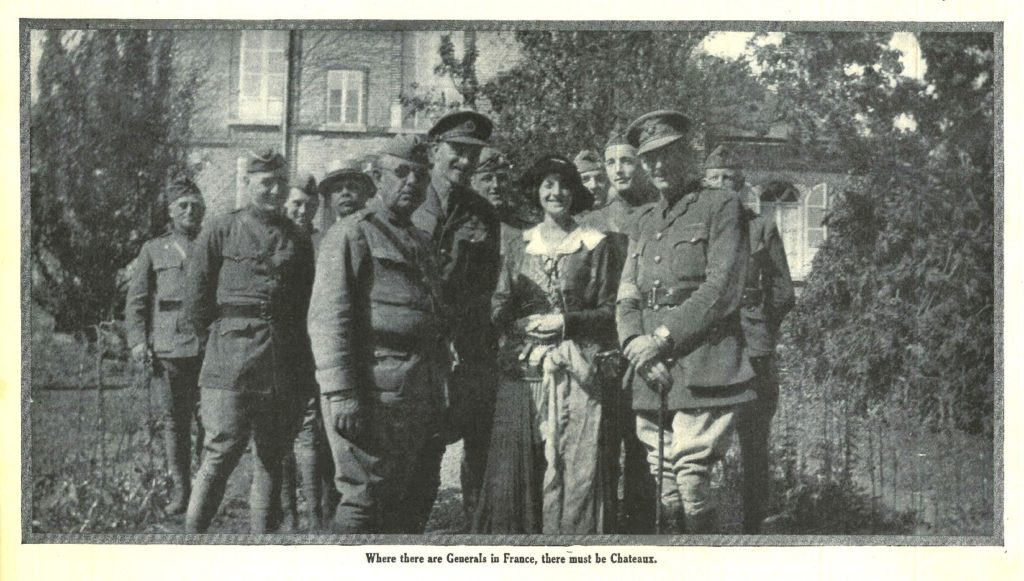
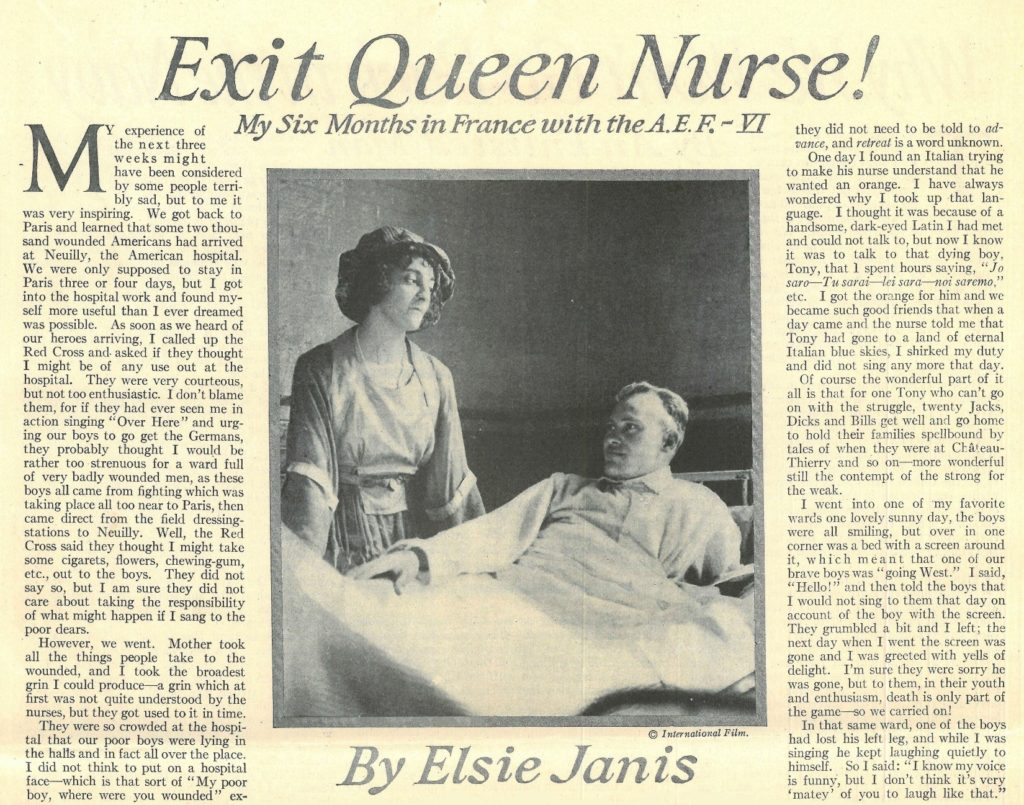
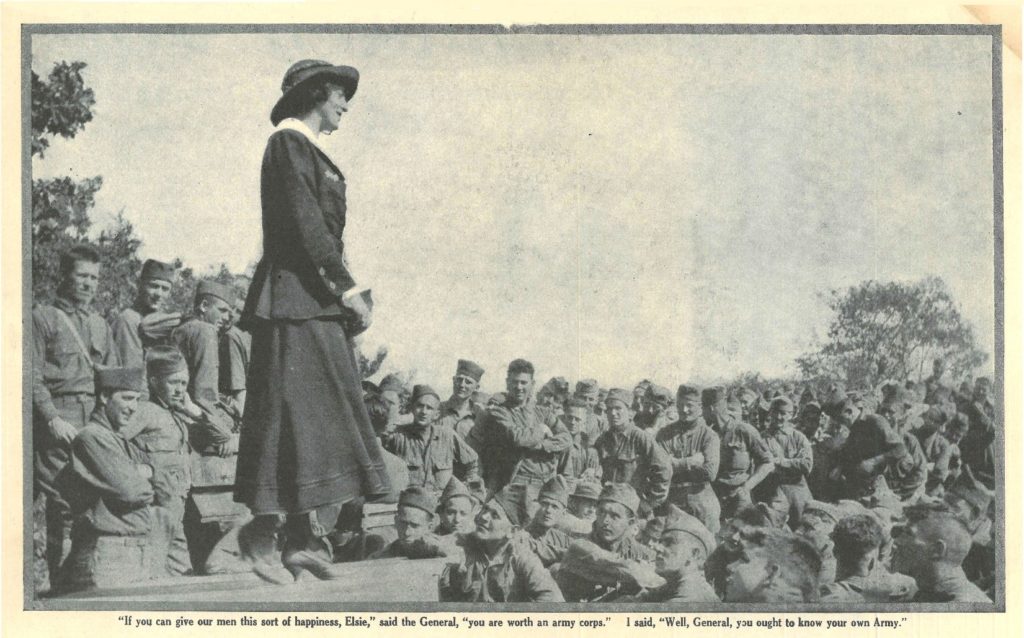
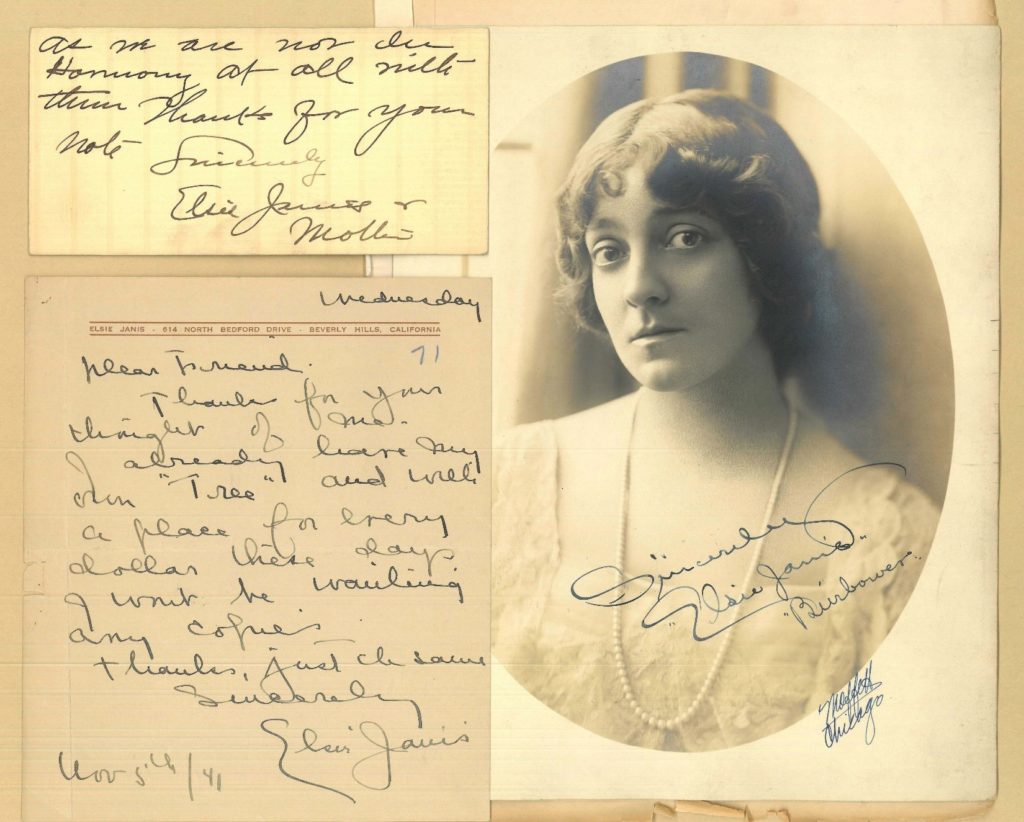
July 11th, 2021 at 1:27 am
Elsie Janis’s wonderful Automobile built especially for her and her mother’s Traveling comforts may have traveled with her to England when she entertained the AEF DURING WWI ? She had the Easton Machine Co. who manufactured the Morse Car install a toilet seat under the rear seat for their long trip comforts. I have a
Picture of Elsie and her dog in the car in 1917 – 18 in front of her Manor home in Sleepy Hallow, NY. Hopefully you can help me find any evidence or pictures of her having that car in England during her travels entertaining the AEF during WWI in 1918. Most Sincerely, Dr. Stan Moody / The Easton Historical Society, Mechanic St., N. Easton, MA CP# 1-508-728-1030 , call me any time to connect. Thank you
November 25th, 2022 at 10:39 pm
I’ve recently learned that my Great-Grandmother, Cora Lee Belt, was an attendant to Little Elsie, likely between 1900-10. Do you have any of her personal writings in your collection which might mention those who worked for her.
January 9th, 2023 at 11:47 am
A Follow up with my previous request above, July 11, 2021. The evidence provided by a rare digitally saved movie clip of Elsie’s late arrival at the ship’s dock in her 1016 Chauffeured driven Morse Car adds evidence to the conclusion that the car never taken aboard since the Chauffeur never went on the trip! He had to drive the car back to Elsie’s home in Sleepy Hollow, NY to await her return in several months to pick up Elsie, her mother and possibly one maid who accompanied them from other readings of her trip. Her Chauffeur later picked them up at the dock upon returning and drove them back to Sleepy Hollow where a picture was taken of Elsie with her mall dog on the running board welcoming her home. This is the only still photograph of her in her 1916 Morse Car Launderette. There is that one digitally saved movie clip that I saw only once of her arriving at the Dock when she departed to France. If any one can tell me where I came across that ( possible News ) clip of her hopping out of the car with excitement at seeing the ship still there please let me know where you saw it? It exists somewhere? CP# 508-728-1030 — Text or Call me where I can retrieve it! Thank You – Dr. Moody, Easton Historical Society & Museum
January 9th, 2023 at 12:00 pm
CORRECTION: Please correct a mistake of the Morse Car year for Elise Janis’s Morse Car! It’s a 1916 manufactured year — NOT A 1016 but A 1916 ! Sorry for the mistake 👍